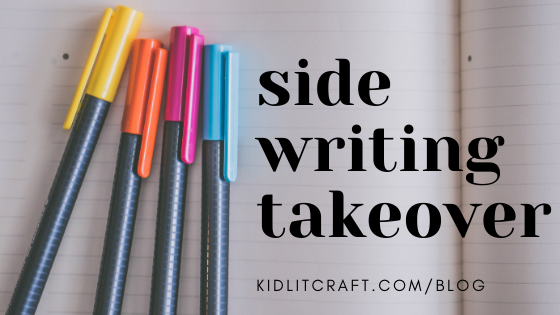hello!
JOIN US IN EXPLORING OTHERS' CRAFT AND BUILDING OUR OWN
Margaret Chiu Greanias: Until I was asked to do this interview, I’d never heard of sidewriting. I thought maybe it was something only novelists did. But as I read Erin Nuttall’s kick-off post, I realized sidewriting is something picture book writers could do too. And then, I realized it was something that I actually do do.
Kristi Wright: “Ultimately, you don’t need to be fancy and organized when it comes to sidewriting. It’s the thing that gets to be as messy as you want it to be. There’s no shame in it–no right way or wrong way. I’m always going to be the equivalent of Charlie Brown’s friend Pig-Pen when it comes to sidewriting, and I’m cool with that.”
Evan Griffith: There’s usually a long period of exploratory writing after I get an idea and before I begin drafting. I’ll write random scenes, character studies, letters from my character to me, and so on, all to get a feel for the mood, tone, and style of the story. If the story takes shape through these exercises—and, crucially, if it holds my interest—then I feel more confident going into the drafting process.
The first time saw the benefit of sidewriting was when I took a course based on Lisa Cron’s Story Genius. In the third week, we were asked to write a scene showing how our protagonist’s misbelief took root. I’d thought about my characters’ misbeliefs before, of course, although I may have called them wounds, flaws, or needs. But I was amazed how much I learned from writing the origin story of that misbelief as a complete scene.
When I don’t know the WHY behind a scene or a character, there is nothing more helpful than stepping away from the manuscript. When I am writing away from my story, I am free to explore my characters, setting, plot, theme…well everything. And since it doesn’t “count,” it also doesn’t have to be good—that is the permission slip I need.
I’m a plotter and and not a panster, but I’m also a writer who tends to completely re-write everything multiple times, and during those re-writes, I typically go in new directions. And every time a new direction comes up, more sidewriting opportunities arise.
I’ve finally discovered a way of dumping this inner perfectionist for at least part of the journey. I learned through trial and error that the keyboard, domain of the delete key, precursor to print, was where my perfectionist tended to take control. Pencil and paper was where my heart led the way. Which is why I began to “channel” my characters through freewriting. Like poetry, freewrites are a way I ditch my inner critic and make the switch from common sense to felt sense, from thoughts to emotions.
For me, writing a novel is about transferring the nebulous ideas in my head to a story that feels true for others. This can be a tricky process! Sidewriting helps me understand what my brain is trying to tell me.
Sidewriting takes us away from linear and helps us explore divergent thoughts and also digs into our subconscious, which actually does know everything about our stories and is just waiting to tell us all about them.
Sidewriting gives me ammo in a story to write a more deeply felt and developed emotional story.
